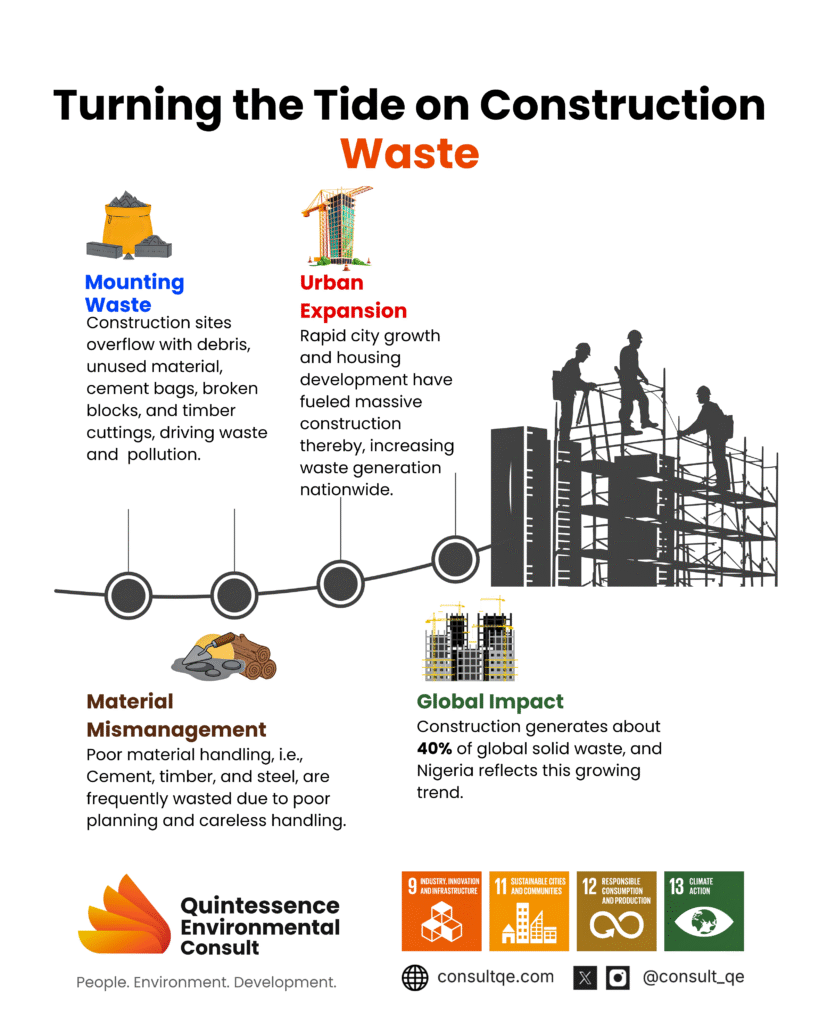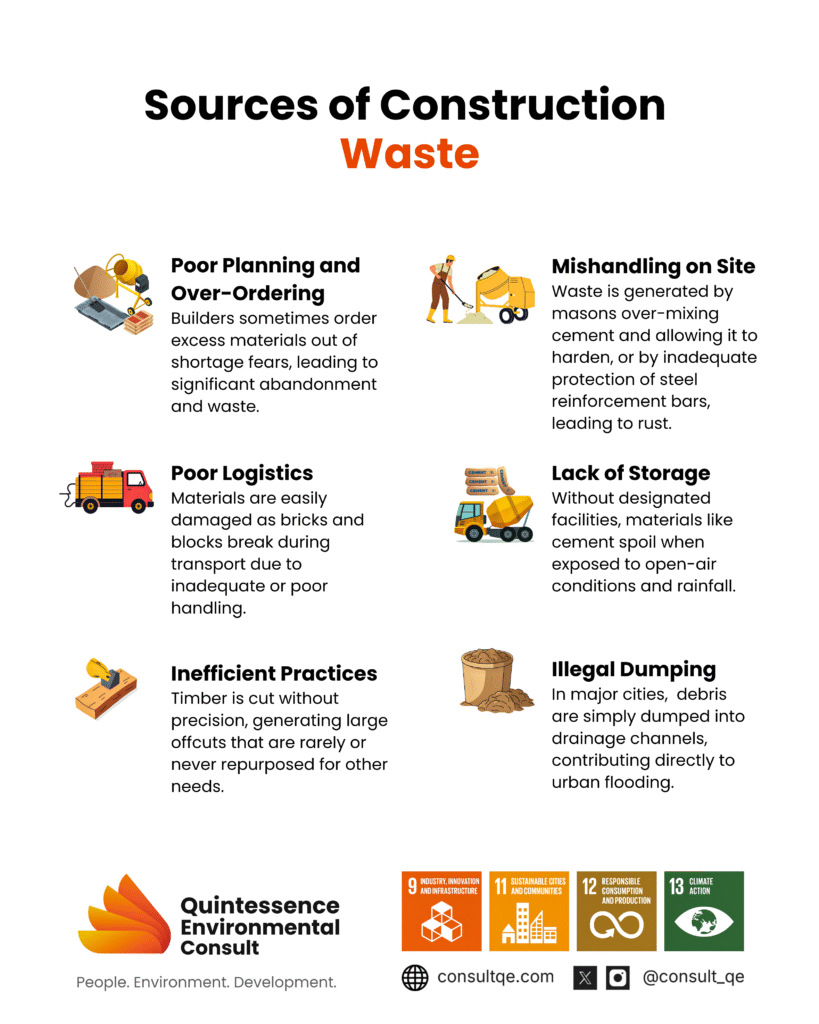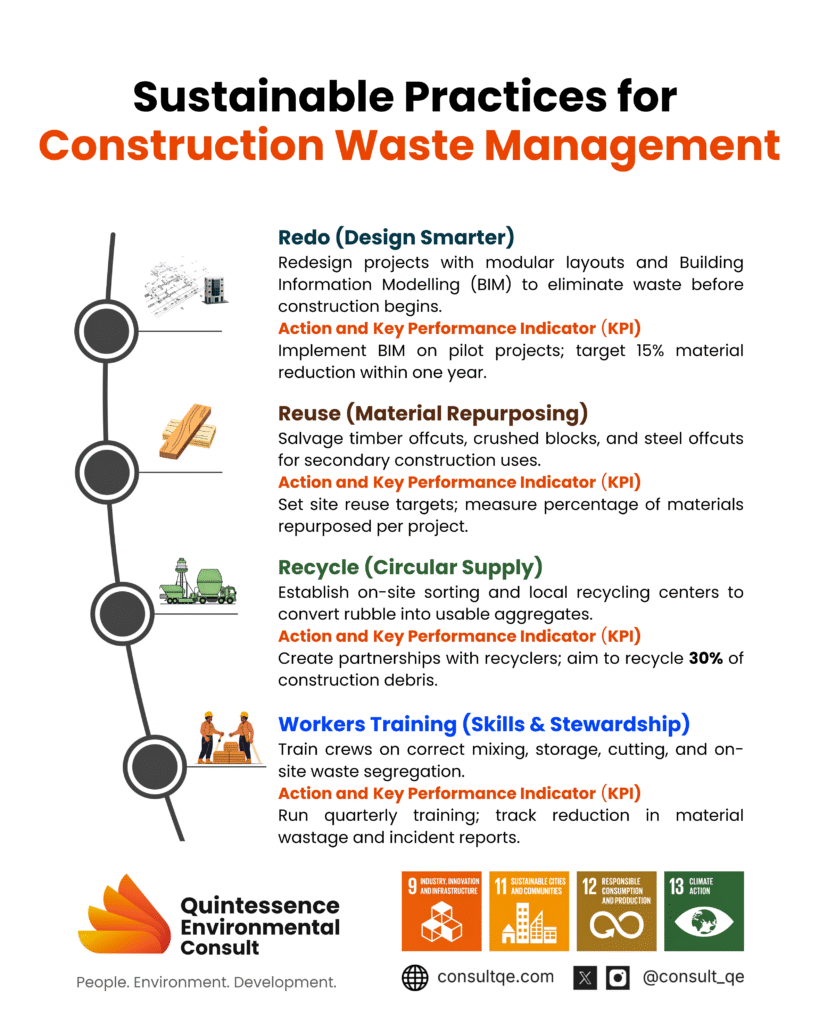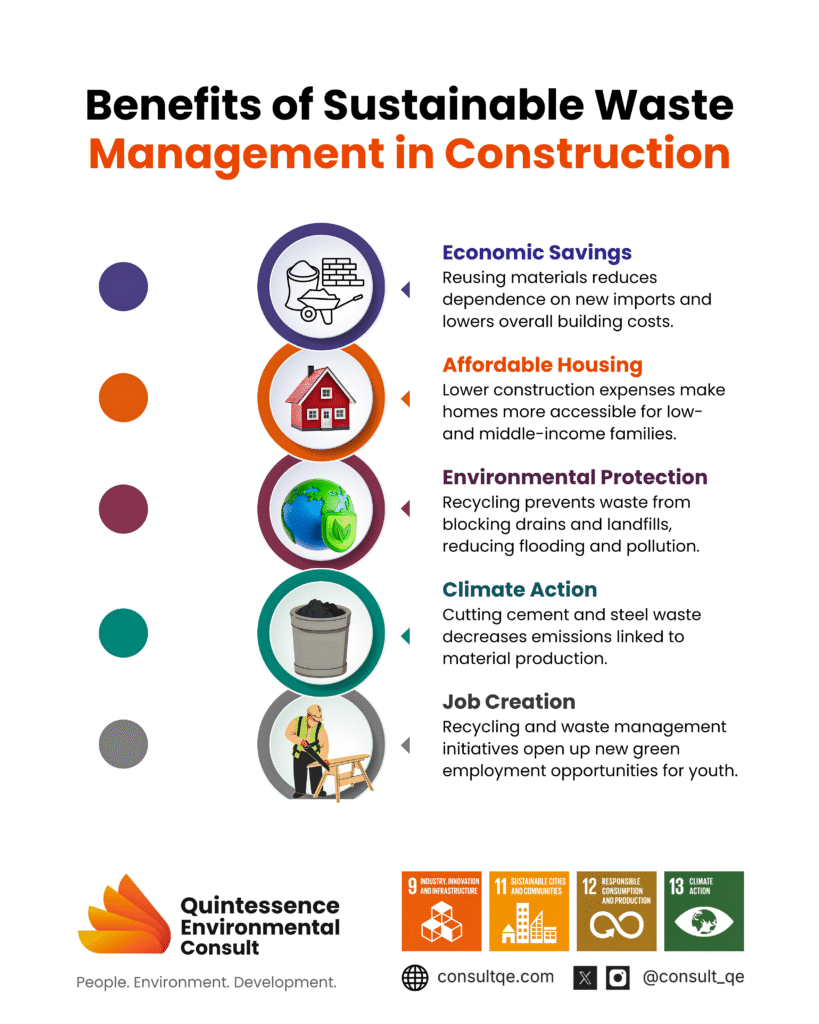KEY TAKEAWAYS
- Nigeria’s construction industry produces large volumes of avoidable waste, mainly because of poor planning, construction errors, weak policy enforcement, and limited recycling infrastructure.
- Although Nigeria has environmental regulations that require waste control on construction sites, their impact is limited because of weak institutional frameworks and poor enforcement.
- Strengthening site waste planning, reducing on-site errors, and establishing recycling facilities can turn construction waste into useful resources that support the economy.
- Experiences from regions like the EU and South Africa show that strong policies and proper recycling systems can reduce waste significantly and create new economic opportunities.
- Investing in proper waste management systems in Nigeria’s construction sector will help protect the environment, create jobs, and align the country with global sustainability goals.

INTRODUCTION
Imagine a building site where piles of cement bags, broken blocks, and timber cuttings grow higher than the house being built. This is the reality of many construction sites in Nigeria today. The waste generated not only drives up project costs but also pollutes the environment, worsening the housing crisis and undermining sustainable development. Nigeria is one of the fastest-urbanizing countries in Africa. According to the United Nations, more than half of Nigerians now live in cities, and by 2050, the urban population is expected to double (United Nations, 2019). This urban expansion has fueled a construction boom, with roads, housing estates, and commercial buildings springing up in almost every state. While this growth supports economic development, it has created a hidden challenge: the massive generation of construction waste.
Cement is Nigeria’s most commonly used building material, with annual consumption exceeding 20 million metric tons (Nigerian Bureau of Statistics, 2020). Yet at construction sites, it is common to see cement wasted during mixing, hardened leftovers dumped after setting, and bags spoiled by moisture before use. Timber, another widely used material, is often cut to sizes that leave large offcuts, while broken blocks and bent reinforcement rods are discarded without reuse. This careless material culture contributes to high construction costs and environmental degradation.
Globally, the construction industry accounts for about 40% of solid waste generation (United Nations Environment Programme [UNEP], 2021). Though Nigeria lacks comprehensive national data, anecdotal evidence suggests construction waste is one of the largest contributors to solid waste in cities like Lagos and Abuja. Unless addressed, this problem will worsen as demand for housing and infrastructure grows.

SOURCES OF CONSTRUCTION WASTE IN NIGERIA
In Nigeria, construction waste arises mainly from poor planning, inefficient material handling, design errors, and weak regulatory oversight. In many cases, materials purchased for construction projects end up as waste before project completion. This loss is driven by a combination of human and systemic factors.
- Over-ordering and Poor Estimation:
Contractors often purchase more materials than required, fearing shortages or project delays, only to have the excess materials abandoned. Inaccurate quantity estimation and limited use of digital design tools result in surplus cement, steel, and blocks that are rarely stored or reused properly. These leftover materials frequently deteriorate or are discarded.
- Transportation and Packaging
Fragile materials such as concrete blocks, tiles, and glass panels frequently break during transit due to inadequate packaging or poor road conditions. The lack of standardized packaging practices increases the likelihood of waste before materials even reach the site.
- Material Handling and Storage Issues:
Many sites lack proper storage facilities and waste segregation areas. Cement bags are stacked outdoors, exposed to humidity and rainfall, leading to spoilage. Timber and steel are left uncovered, increasing their susceptibility to rot and rust. Timber is cut without precision, producing offcuts that are rarely reused.
- Lack of Recycling and Waste Management Systems:
Nigeria lacks centralized facilities for sorting and recycling construction and demolition (C&D) waste. In major cities like Lagos, site debris such as broken blocks and stone chips is simply dumped indiscriminately into drains or open lands, worsening urban flooding and pollution.
CURRENT PRACTICES OF CONSTRUCTION WASTE MANAGEMENT IN NIGERIA
Nigeria does have legal and regulatory instruments that touch on construction waste. The NESREA Act (2007) establishes the National Environmental Standards and Regulations Enforcement Agency with broad responsibility for environmental standards, and the Construction Sector Regulations (2011) require operators on new construction projects to prepare Site Waste Management Plans (SWMPs) and use best available techniques to minimize pollution. In practice, however, these requirements are unevenly applied across states and projects. Federal regulations exist, but enforcement is often local and inconsistent. (National Environmental Standards and Regulations Enforcement Agency [NESREA], 2011) (NESREA Act, 2007).
Common practical measures on Nigerian sites today include ad hoc waste segregation (where contractors are aware), informal reuse of small timber offcuts or bricks, informal recycling by scavengers or local aggregators, and occasional ad hoc crushing of concrete for local backfill. Lagos State has been more proactive on plastic bans and local waste controls, showing how subnational action can work alongside federal frameworks. Nevertheless, structured, large-scale recycling infrastructure for C&D waste is limited in most cities, and formal markets for sorted C&D streams are still developing. (Ogunmakinde, a2022).
Construction Errors, Rework, and Weak Institutional Frameworks
Two technical and governance issues multiply waste volumes on site. First, construction errors and rework are significant. Concrete overmixing, poor curing, inaccurate cutting of blocks or timber, and damaged materials from poor handling produce avoidable waste that often accounts for a high percentage of on-site material loss. NBRRI investigations into building failures in Nigeria note problems such as poor concreting and block quality issues that lead to repair, rebuild, and thus more waste. (Aboginije, 2021)(Nigerian Building and Road Research Institute [NBRRI], 2013).
Second, weak institutional and policy frameworks reduce the effectiveness of regulations. Although NESREA and related regulations exist, enforcement gaps, unclear mandates between federal and state agencies, and lack of mandatory reporting for C&D waste streams mean many builders operate without robust SWMPs. Several academic reviews identify this governance gap as a primary barrier to circular practices in Nigerian construction. (Onu, 2012)(Chidiobi, 2022).
Global Lessons
Across several regions of the world, the right mix of policy and infrastructure has proven critical to achieving high recovery rates for construction and demolition (C&D) materials. In the European Union, for instance, well-defined policy frameworks, standardized recycling systems, and thriving secondary materials markets have driven remarkable progress.
Recent analyses show that the EU now recovers and reuses a large share of its C&D waste — a success attributed to clear regulations, established recycling standards, and producer responsibility schemes that make waste recovery both viable and profitable. These experiences clearly demonstrate that high recovery and reuse rates are not just aspirational — they are technically and economically achievable when strong policy direction aligns with market incentives and robust infrastructure. (Caro, 2024).
In Africa, South Africa has documented very large C&D flows—studies estimate tens of millions of tonnes—and has active crushing and recycling operations in urban centers such as Cape Town. Research shows that, with investment, significant portions of C&D waste can be converted into secondary aggregates and road base materials; these activities create local jobs and reduce the demand for virgin aggregate. South Africa’s experience suggests Nigeria could capture economic value by formalizing C&D recycling, especially for concrete and masonry rubble. Berge, S., et al. 2022).

SUSTAINABLE PRACTICES FOR WASTE REDUCTION IN NIGERIA
Reducing waste in Nigeria’s construction sector requires a shift from reactive cleanup to proactive planning, material efficiency, and circular practices. To reverse this trend, Nigerian builders can adopt a range of sustainable waste reduction practices:
- Reuse of materials: Reusing building components can drastically cut material consumption and costs. Timber offcuts can be repurposed for scaffolding, formwork, or smaller structural pieces. Broken concrete blocks and tiles can be crushed and reused as aggregates in concrete or road foundations. Steel offcuts can be remelted and fabricated into new rods.
- Recycling initiatives: The government and private companies can set up recycling centers where scrap metal, timber, sand, and rubble are sorted and reused. In countries like South Africa, such initiatives have cut construction waste by up to 30%. Nigeria could learn from these models.
- Efficient planning and design: Architects and engineers can minimize waste through precise calculations, modular designs, and digital tools such as Building Information Modelling (BIM). BIM allows for virtual simulations of projects, enabling better forecasting of material quantities and reducing over-ordering. Better project supervision ensures that materials are not wasted during mixing, cutting, or storage.
- On-site training and Awareness: Construction workers often waste materials because they lack knowledge of sustainable methods. Training programs in material storage, mixing ratios, and waste segregation can significantly improve site efficiency.
By embedding these practices into everyday construction, Nigeria can move toward a more resource-conscious building culture.

BENEFITS OF SUSTAINABLE WASTE MANAGEMENT
Implementing sustainable waste management practices in Nigeria’s construction industry delivers multi-dimensional benefits — economic, environmental, and social. Beyond reducing costs, these practices support national goals on housing, climate resilience, and green job creation.
- Economic savings: Reusing materials cuts down the cost of importing new resources. For example, using crushed block waste in road bases reduces the need to buy new gravel.
- Affordable housing: Lower material costs can help reduce the high price of housing in urban areas, making homes more accessible for low-income families.
- Environmental protection: Recycling and reuse prevent construction waste from clogging drains and landfills, reducing urban flooding and pollution.
- Climate action: Cement and steel production are major sources of greenhouse gas emissions. Reducing waste lowers demand for these materials, indirectly reducing emissions.
- Job creation: Recycling centers and waste management systems could create new green jobs for Nigeria’s youth population.
These benefits show that waste reduction is not merely a technical fix but a pathway to a greener and more inclusive economy.
CONCLUSION
Reducing construction waste in Nigeria is both a technical and governance challenge. Technically, many solutions are ready: better site planning, measurement and order control, on-site sorting, crushing and reuse of concrete, reuse of timber offcuts, and modular designs that minimize offcut waste. These reduce direct material costs and limit environmental harm. Economically, turning rubble into secondary aggregates reduces dependence on quarried material and can lower infrastructure costs. Evidence from EU and South African practice shows this is economically viable when matched with policy and market supports. (Berge, 2022) (Caro, 2024).
From a governance perspective, the pathway is clear: stronger enforcement of existing rules (including mandatory SWMPs for larger projects), subnational pilots to build recycling markets, incentives for developers who deliver low-waste projects, and training to reduce construction errors and rework. Better national-level data collection is also essential. Many Nigerian studies note a troubling lack of a single national C&D waste inventory; improving data quality will help prioritize interventions and attract investment. (Ogunseye, Ogunseye, & Ogunseye, 2023).
Construction waste in Nigeria is large and partly avoidable. Practical wins exist now: enforce and expand mandatory site waste planning, invest in local recycling/crushing facilities, train site teams to reduce errors and rework, and use subnational policy experiments to build markets for secondary materials. These measures will save money, create jobs, reduce flood and health risks, and align Nigeria’s building sector with global sustainability goals.
REFERENCES
- Aboginije, A., et al. (2021). A Holistic Assessment of Construction and Demolition Waste in Nigerian projects. Sustainability. (See overview and related literature). https://www.mdpi.com/2071-1050/13/11/6241
- Berge, S., et al. (2022). An estimate of construction and demolition waste quantities and composition expected in South Africa. South African Journal of Science / related outputs. Demonstrates large C&D streams and recycling potential in South Africa. https://sajs.co.za/article/view/12485
- Chidiobi, C. C. (2022). Development of Frameworks for the Management of Materials Procurement and Construction Waste for Contractors in Nigeria (Doctoral thesis). University repository. Retrieved from UWE repository.
- Caro, D., Lodato, C., Damgaard, A., Cristóbal, J., Foster, G., Flachenecker, F., & Tonini, D. (2024). Environmental and socio-economic effects of construction and demolition waste recycling in the European Union. Science of the Total Environment, 908, 168295. https://doi.org/10.1016/j.scitotenv.2023.168295
- National Environmental Standards and Regulations Enforcement Agency (NESREA). (2011). National Environmental (Construction Sector) Regulations. [Regulation requiring site waste management plans]. https://nesrea.gov.ng/wp-content/uploads/2025/05/Construction_Sector_Regulation-2011-.pdf
- NESREA Act (2007). National Environmental Standards and Regulations Enforcement Agency Act. https://nesrea.gov.ng/ or full text PDF. https://nesrea.gov.ng/ and full Act PDF https://nesrea.gov.ng/wp-content/uploads/2025/05/NESREA-ACT.pdf
- Nigerian Building and Road Research Institute (NBRRI). (2013). Construction for Durability in Nigeria: Building Digest. Technical reports on material performance and causes of failures that drive rework. https://nbrri.gov.ng/new/wp-content/uploads/2019/06/Construction-Building-digest-3.pdf
- Nigerian Bureau of Statistics. (2020). Nigerian cement production and consumption report 2020. NBS.
- Ogunmakinde, O. E. (2022). Construction Waste Management in Nigeria Using the 3R Principles. Research output discussing gaps and the circular economy approach. [Bond University Research]. https://research.bond.edu.au/files/186724331/AM_Construction_Waste_Management_in_Nigeria.pdf
- Ogunseye, N. O., Ogunseye, O. D., & Ogunseye, A. O. (2023). Construction and demolition waste management in a developing country: A Nigerian scenario. Journal of Sustainability Perspectives, 3(1), 11–23. https://doi.org/10.14710/jsp.2023.15413
- Oladokun, T. T., & Adedeji, Y. M. D. (2018). Traditional building materials and design for sustainable housing in Nigeria. International Journal of Sustainable Construction Engineering and Technology, 9(2), 15-23. https://doi.org/10.30880/ijscet.2018.09.02.002
- Onu, Benefit & Dr, T. & Surendran, Suresh & Ebie, Samuel. (2012). Solid waste management: A critique of Nigeria’s waste management policy. International Journal of Knowledge, Culture and Change Management. 11. 373-399.
- United Nations. (2019). World urbanization prospects: The 2018 revision. UN Department of Economic and Social Affairs. https://population.un.org/wup/
- United Nations Environment Programme (UNEP). (2021). 2021 global status report for buildings and construction: Towards a zero-emissions, efficient and resilient buildings and construction sector. UNEP. https://globalabc.org
- https://www.reuters.com/sustainability/nigeria-ban-single-use-plastics-next-year-2024-06-26/

Very insightful